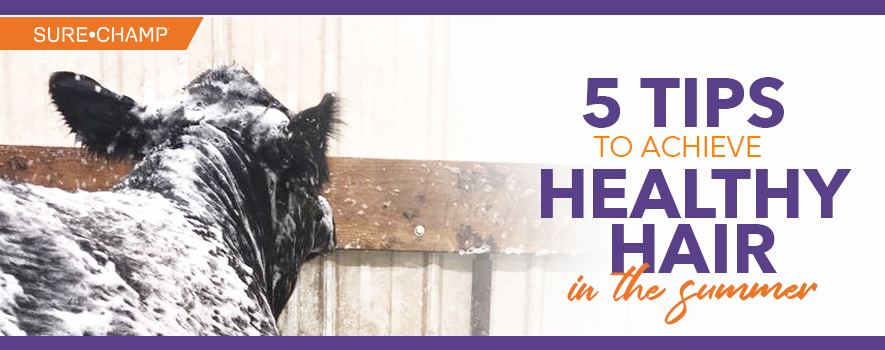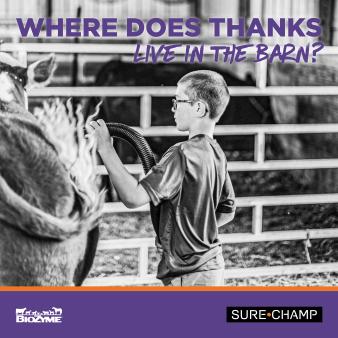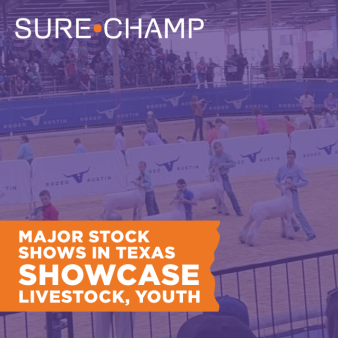
It is NO secret. It is A LOT more fun to work on achieving a healthy hair coat in the winter and early spring. Outside temperatures are cooler, cattle are shaggy, and they are naturally growing plenty of hair on their own. But growing hair for the summer is a different story. You go out to the barn and your cattle are itchy and rubbing because of dry skin, it’s hot outside and hair is DEAD. Growing hair in the summer takes much more effort and dedication, but it isn’t impossible to achieve if you establish a routine and keep things systematic.
1. Shed it or Shear it
In the same way you pack away your winter coats when spring and summer come – you need to get rid of your calf’s winter coat of hair before you can focus on new growth. The average hair growth cycle for show cattle is 90 days, thus you should aim to have all the old, dead hair removed 90 days prior to your targeted goal. For example, if your state or county fair is in August, you should plan to have the hair removed by mid-May. There are two basic ways to shuck the dead hair.
The fastest way, and arguably the most common method is to shear your calf. This can be done with a plucking blade or a beveled come or blade. Start at the topline of your animal and clip in a downward stroke all the way to the belly line. At this point you should leave and blend about 1-2 inches of hair above the belly line, hind quarter and fore arm. Additionally, you can leave the tailhead hair and blend it the same way you blend the hair below the belly line. There is a good chance that in some parts of the country, you have already shorn your calf. Depending on your spring show season, some calves will get shorn in the first part of March. However, by the end of April, all cattle should be shorn off if you are expecting to grow healthy summer hair. Once your animal is shorn, you might want to consider using a pour-on product like prolate to kill any lice or external pests that cause dry skin or itching.
The second method for dead hair removal is to use a shedding tool like a shedding comb or brush. This method is going to take a lot more muscle, dedication and time, but it is effective to ensure the that any new, healthy hair growing is not lost. You will want to make sure to start this process early and use the shedding comb often to get all the dead hair removed in time.
2. It’s a go for H2O
When the old hair is gone, it’s time to promote a new, healthy hair coat and that starts with getting them on the wash rack. Rinsing your animal at least once, if not twice a day and using conditioner will help to start and promote new hair growth. You should try to limit the amount of times you wash with soap to about once or twice a week. The more you use soap, the more it dries out the skin and hide which can encourage your cattle to itch and rub.
If it is warm outside, make the most of your time spent rinsing. Start the cold water on their feet and legs, then belly and work your way up the calf. Make sure you spend the time to really cool them off and get cool water all over their body; this will help to lower their overall body temperature.
3. Work, Work, Work the Hair
After rinsing, there is really no need to blow your calf out with such little hair, so you should focus on getting them dry by brushing. Get your animal tied up in the barn under fans and brush the hair straight forward with either a rice root brush or a plastic wash brush. If you want to grow hair, you have to brush A LOT in order to stimulate the hair follicles to grow (until if feels like your arm might fall off). Once you have made several passes brushing forward, and your calf starts to grow a little more hair, you can start working the hair more at a 45-degree angle. When your calf is dried from brushing or from standing under the fans, you should apply some sheen or light oil to keep the hair hydrated and fresh.
Keeping hair and skin hydrated this time of year is so important. With so much rinsing and brushing, you are stripping the hair and skin of its natural oils each time, and thus it is vital that you condition the skin and apply some type of product after each rinsing and brushing session to ensure that some of the natural oils are restored to the animal and its hide is healthy. Keep in mind, whatever oil or product you use should be very light. You want to steer clear of heavy oils, as these will only heat your animal up more and also matte the hair, attracting dirt to cling to it. Keep it light, keep it clean and keep it hydrated!
4. Create a Cold Spell in the Midst of Summer
Hair growth is all related to the mind and body working together. If the animal thinks it is preparing for winter, they will most likely grow a thicker hair coat at a faster rate. However, without some barn management, it’s not going to feel much like winter during the longer, brighter days of spring and summer. If you have a cooler, make sure to get your calves rinsed and tied in early in the morning and turned out later when the sun goes down. If you don’t have a cooler, the same rules apply. Try to find a place in your barn where you can turn the lights off or reduce the amount of daylight. Tie your calf in under fans early, work their hair and perhaps rinse again and turn out later in the evening when temperatures decrease. When it comes to hair growth in the summer, it’s about mind over matter.
5. Pay Attention to What’s in the Pan
The last step to consistent and healthy hair growth is to make sure you are following a good nutrition program, and your calf is receiving the nutrients vital to hair growth. Make sure your animal is getting a quality vitamin or mineral supplement like Sure Champ®. Sure Champ Cattle, Sure Champ Spark® and Sure Champ Extreme with Climate Control all contain biotin and zinc to help support healthy hair and hoof growth. Additionally, many exhibitors also add melatonin to their feed, which specifically targets hair growth.
If you want healthy hair in the heat of summer, you have to be prepared to work hard. But with all things, you get out what you put in. Make a plan and work your plan EVERY. DAY. to make healthy hair a reality.

